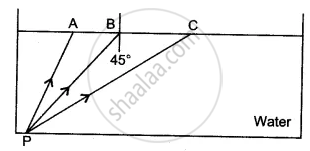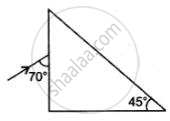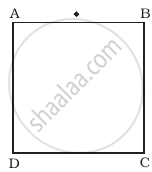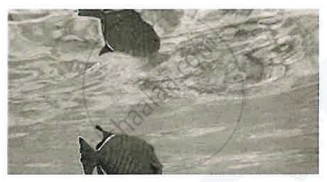Advertisements
Advertisements
प्रश्न
Solve Numerical example.
From the given data set, determine angular dispersion by the prism and dispersive power of its material for extreme colours. nR = 1.62 nV = 1.66, δR = 3.1°
उत्तर
Given: nR = 1.62, nV = 1.66, δR = 3.1°
To find: i. Angular dispersion (δVR)
ii. Dispersive power (ωVR)
Formula: i. δ = A (n − 1)
ii. δVR = δV − δR
iii. ω = `(δ_"V"-δ_"R")/(((δ_"V"+δ_"R")/2))`
Calculation: From formula (i),
δR = A(nR − 1)
∴ A = `δ_"R"/(("n"_"R"-1))=3.1/((1.62-1))=3.1/0.62`
∴ δV = A(nV − 1) = 5 × (1.66 − 1) = 3.3°
From formula (ii),
δVR = 3.3 − 3.1 = 0.2°
From formula (iii),
ωVR = `(3.3-3.1)/(((3.3+3.1)/2))=0.2/6.4xx2=0.2/3.2=1/16`
= 0.0625
- Angular dispersion by prism is 0.2°
- Dispersive power of material of prism is 0.0625.
APPEARS IN
संबंधित प्रश्न
Draw the diagram of a right-angled isosceles prism which is used to make an invented image erect
Name two factors which affect the critical angle for a given pair of media. State how do the factors affect it.
Total internal reflection occurs only when a ray of light passes from a ______ medium to a ______ medium.
Total internal reflection can take place only if ______.
Plot a graph between
Angle of incidence versus angle of reflection,
Plot a graph between
Angle of incidence versus angle of refraction.
Why do diamonds sparkle?
If a ray of light passes from medium I to medium II without any change of direction, what can be said about the refractive indices of these media (angle I is not 0)?
How are critical angles related to the refractive index of the medium?
What is meant by the statement, ‘the critical angle for diamond is 24°’?
The diagram shows a point source P inside a water container. Three rays A, B, and C starting from P are shown up to the water surface. Show in the diagram the path of these rays after striking the water surface. The critical angle for the water-air pair is 48°.

Complete the following diagram to show the path of the ray of a single colour in the diagram as if enters in and emerges out of the prism. Mark the angles wherever necessary. (Critical angle for glass = 42°).

Choose the correct option.
Angles of deviation for extreme colours are given for different prisms. Select the one having maximum dispersive power of its material.
Answer the following question.
Under what conditions are total internal reflection possible? Explain it with a suitable example.
Answer the following question.
Define the critical angle of incidence and obtain an expression for it.
Solve Numerical example.
A monochromatic ray of light is incident at 37° on an equilateral prism of refractive index 3/2. Determine angle of emergence and angle of deviation. If angle of prism is adjustable, what should its value be for emergent rays to be just possible for the same angle of incidence?
Critical angle of light passing from glass to air is maximum for ____________.
The resultant `vec"R"` of `vec"P"` and `vec"Q"` is perpendicular to `vec"P"`. Also `|vec"P"|=|vec"R"|`. The angle between `vec"P"` and `vec"Q"` is ______.
[tan 45° = 1]
For total internal reflection to take place, the angle of inddence i and the refractive index µ of the medium must satisfy the inequality ____________.
Optical fibre communication uses the principle of ______.
What are the examples of total internal reflection in nature?
The phenomena involved in the reflection of radiowaves by ionosphere is similar to ______.
A rectangular block of glass ABCD has a refractive index 1.6. A pin is placed midway on the face AB (Figure). When observed from the face AD, the pin shall ______.

- appear to be near A.
- appear to be near D.
- appear to be at the centre of AD.
- not be seen at all.
State the condition under which total internal reflection occurs. Give the mathematical expression for total internal reflection.
Which of the following is used in optical fibres?
- Assertion (A): Propagation of light through an optical fibre is due to total internal reflection taking place at the core-cladding interface.
- Reason (R): Refractive index of the material of the cladding of the optical fibre is greater than that of the core.
An endoscope uses optic fiber to transmit high resolution images of internal organs without loss of information. The principle of light that is used by the optic fiber is based on ______.
The diagram below shows a fish in the tank and its image seen in the surface of water.

Name the phenomenon responsible for the formation of this image.
